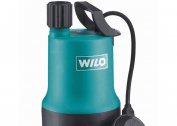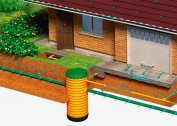Not so long ago, builders and home craftsmen had no questions regarding the choice of pipes for laying sewers - only steel and cast iron products were produced. Currently, polypropylene, polyvinyl chloride, and polyethylene are used as the manufacturing material. In addition, manufacturers use different colors, which simplifies the determination of its characteristics. In the article, we will understand how they differ and why pipes of different colors are intended.
Criterias of choice
 The color separation of the pipes is used to simplify the choice of variety for certain operating conditions. So when choosing, the following criteria should be considered:
The color separation of the pipes is used to simplify the choice of variety for certain operating conditions. So when choosing, the following criteria should be considered:
- The pipe laying place is an apartment or a private house. Accordingly, the presence or absence of soil pressure is taken into account, which depends not only on its volume, but also on the future location on the surface of the road, parking, etc.
- Weather conditions in the current region, in the context of the depth of freezing of the soil.
- Operating temperature range.
Now we will consider the characteristics and purpose of pipes of different colors to easily cope with their choice.
Gray pipes
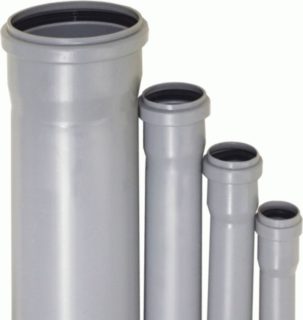 Used indoors, where there is no strong mechanical and thermal effects. The material of manufacture is polypropylene. Gray pipes are designed for the temperature of the liquid passed through them within 60-75 degrees. However, they can withstand a short-term increase in the indicator to 90-95 degrees. Outside temperature should not fall below 0 °.
Used indoors, where there is no strong mechanical and thermal effects. The material of manufacture is polypropylene. Gray pipes are designed for the temperature of the liquid passed through them within 60-75 degrees. However, they can withstand a short-term increase in the indicator to 90-95 degrees. Outside temperature should not fall below 0 °.
They are distinguished by chemical inertness: there are no corrosive processes and emissions of harmful substances.
Since the deformation occurs with a relatively small effort - 50-75 kgf / m2, then such pipes are not recommended to be installed in places where external pressure will be exerted on them. Use for external sewage is justified only by financial savings, which, however, may result in the need to dig a trench and replace the entire drain.
White pipes
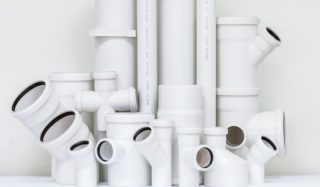 Also used for indoor installation. By their properties they do not differ from the previous variety. They have a more attractive appearance, so they can be laid in places where it is impossible to finish the walls or floor to hide communications.
Also used for indoor installation. By their properties they do not differ from the previous variety. They have a more attractive appearance, so they can be laid in places where it is impossible to finish the walls or floor to hide communications.
Distinctive features of white pipes are good thermal and noise insulation. Withstand fluid temperature up to 95 degrees. Diameter ranges from 32 mm to 150 mm. The length of a single piece can be from 15 cm to 5 meters.
For ease of installation, manufacturers place a centimeter scale on the surface of the pipes, which simplifies the process of measuring the required dimensions.
Red pipes
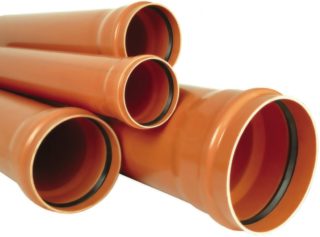 They are used to create sewers outside the house. The material of manufacture is polyvinyl chloride. Such pipes are more durable, which varies depending on the class of the product:
They are used to create sewers outside the house. The material of manufacture is polyvinyl chloride. Such pipes are more durable, which varies depending on the class of the product:
- L - can withstand loads up to 200 kgf / m2;
- N - up to 400 kgf / m2;
- S - up to 800 kgf / m2.
Another classification assumes differences in wall thickness: pipes marked SN4 have a thickness of 3 mm, SN8 - 3.3 mm.
Orange pipes are not able to tolerate the heat of fluid passing through them. The working range is 40-60 degrees. External exposure to negative temperature does not affect the properties of the material.
Red pipes support the weight of the soil, if the depth of the laying does not exceed 2 meters. Placement under roads is not recommended, since there is a high probability of deformation, which ultimately leads to subsidence of the solid components of the wastewater and the formation of blockage.
Significant disadvantages of pipes made of polyvinyl chloride include:
- Destroy under the influence of aggressive effluents - acids or oils. If you plan to merge such materials, you should pay attention to a separate class of the NPVH product, which has special properties.
- Elongation of material when exposed to high temperature.
They can be made in the form of a smooth cylindrical pipe or corrugated, characterized by higher strength.
Black pipes
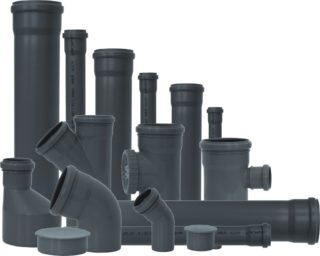 They are made of polyethylene and are often used in the organization of urban sewage systems, which must withstand significant volumes of passing fluid. A characteristic feature of black pipes is the diameter - usually this figure varies between 250-850 mm. However, there may be wider pipes with increased traffic.
They are made of polyethylene and are often used in the organization of urban sewage systems, which must withstand significant volumes of passing fluid. A characteristic feature of black pipes is the diameter - usually this figure varies between 250-850 mm. However, there may be wider pipes with increased traffic.
Among the advantages stand out:
- resistance to possible water hammer;
- the absence of corrosive processes in contact with active substances;
- increased service life - from 50 years.
They are installed mainly at great depths - up to 15 meters. Strength is achieved by corrugated walls that are smooth on the inside. The temperature of the passing fluid should not exceed 60 degrees.
The second purpose of such pipes is protection for the cable, which is laid underground. Varieties used for drainage are also distinguished.
The cost of black pipes is relatively not high, while the positive side is durability. Polyethylene is resistant to temperature changes, is not subject to corrosion. Installation does not require a special tool, only a compression fitting.
Green pipes
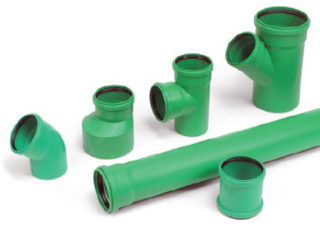 Pipes that are used to organize drainage are painted in green (sometimes blue) color. A distinctive feature is the ability to bend and withstand the strong pressure of the soil settling on top.
Pipes that are used to organize drainage are painted in green (sometimes blue) color. A distinctive feature is the ability to bend and withstand the strong pressure of the soil settling on top.
Since the product is used in the external environment, the material can easily tolerate temperature fluctuations, as well as its decrease to negative values. There may be perforations on the walls that allow water to enter. Some manufacturers equip their products with a geotextile filter.
To summarize. For home use, gray pipes are suitable, if the sewer goes into the ground, then in this place it is advisable to switch to orange pipes. White have the same properties as gray, but are more attractive in appearance. Black - characterized by increased size and are used for laying urban sewers. Greens are used for drainage.
When choosing pipes, the main attention should be paid to the material of manufacture and its properties. They must meet future operating conditions, otherwise the service life of the products will be significantly reduced.
